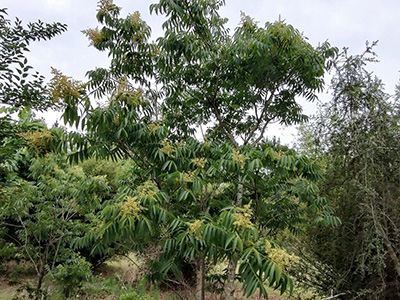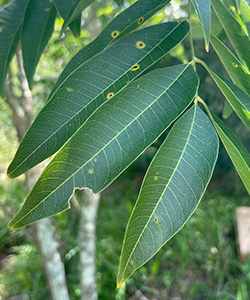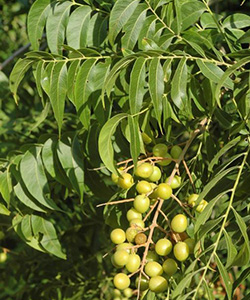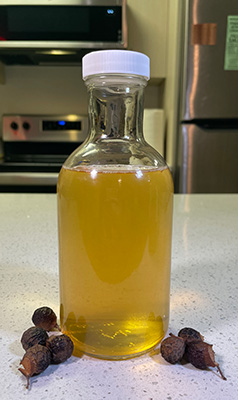Soapberry

Florida soapberry tree. Photo courtesy of Scrubland Farmz in Fort McCoy, Florida.
Looking to add more functional ornamentals to your landscape? Soapberry is an attractive tree that also supplies fruits for making soap. We have two North America native varieties to choose from: Florida soapberry and western soapberry. They have slightly different appearances, but both trees produce berries that can be turned into dish soap, laundry detergent, shampoo, and more.
Florida Soapberry
Florida soapberry or wingleaf soapberry (Sapindus saponaria) grows best in zones 10A to 11, so this one is a good choice for Central and South Florida gardeners. The trees max out at 30 to 40 feet tall and 25 to 35 feet wide with drooping branches.
Leaves are evergreen and pinnately compound; they are made up of linear leaflets with smooth margins. The bark is gray with a rough texture. Small, inconspicuous white flowers appear year-round except in the summer and lead to showy, golden berries that are about an inch in diameter. The seeds within the berries are poisonous, so make sure you plant this tree where children and pets don’t have access to it.

Long narrow leaves of Florida soapberry.
Florida soapberry is low maintenance and tolerant of most conditions. It prefers to grow in full sun and won’t be bothered by salt or drought. Some pruning is recommended initially to develop a strong branch structure, but little maintenance is required after establishment. Pest or disease issues are uncommon. You can easily propagate more trees from seeds, so Florida soapberry makes a great pass-along-plant.
Western Soapberry
Western soapberry (Sapindus drummondii) is native to Central and Western Texas and is suited to zones 6A to 9B, which includes much of Florida. It gets a bit larger than Florida soapberry, with a max height of 40 to 50 feet and a similar spread. It is an ideal shade tree with a varying canopy that can be round to vase shaped.
The foliage is made up of pinnately compound leaves. The leaflets are lanceolate to oblong, medium green, and glossy with downy undersides. The trees put on a vibrant yellow show in the fall before dropping their leaves in the winter. In the spring, panicles of yellowish flowers appear. Then, the flowers lead to clusters of translucent, yellow, grape-like fruits that are only half an inch in diameter. The fruits eventually turn black and persist on the tree after the leaves are gone, providing winter interest. The attractive bark is chunky, peeling, and red- or greyish brown.

Western soapberry. Ronald F. Billings, Texas A&M Forest Service, Bugwood.org
Western soapberry will grow in either full or partial sun, although it will have a denser crown with more sunlight. It tolerates most soils, wind, and drought (although it is not salt tolerant). Keep in mind the fruits are quite firm when they drop, which can be a tripping hazard if the tree is next to a sidewalk or driveway. Like its Florida cousin, the seeds are also poisonous, so plant it away from the reach of children. Propagation is easy from either cuttings or seeds, but this also means that you may have volunteer seedlings pop up around your yard if you don’t mow them.
Minimal irrigation or pruning is needed while establishing western soapberry. It rarely succumbs to pests or diseases; in fact, it appears to be resistant to root rot. Mistletoe growing on the tree is a common issue. Western soapberry is ideal for landscapes since it requires almost no maintenance and is extremely stress tolerant.
Contact the experts at your county Extension office with any questions as you grow soapberry.
Making Soap
The most versatile product that soapberry can be processed into is a liquid soap mixture. This base can be mixed with other ingredients to make various products.
When preparing the soap mixture, you only need the skin from dried soapberries. If yours are whole, peel the husks away from the seeds to use in this recipe. Be sure to save the seeds for future planting.
Here is our suggested method for making liquid soap:
- Boil a liter of water in a saucepan for every ten soapberries.
- Add your soapberry husks and boil for about 20 minutes, stirring occasionally.
- Remove the saucepan from heat and allow it to cool completely.
- Strain the liquid to remove the soapberry husks.
- Pour the liquid into a container and add two teaspoons of apple cider vinegar per batch as a natural preservative.
- Don’t worry if your liquid looks waterier than storebought soap; this is normal. Soapberry soap is thinner and less sudsy than commercial soaps (but no less effective). The liquid should be an amber color.

If you’d like to give your soap a scent, add a few drops of your favorite essential oil. You can use this liquid soap as laundry detergent, dish soap, shampoo, body wash, and hand wash. It can also work as a stain remover by spraying it onto stains before your clothes go in the wash. Add some extra vinegar to your soap and now you have a multi-purpose cleaner.
If you’d like to grow sponges to use with your homemade soap, check out our article on luffa gourds.

